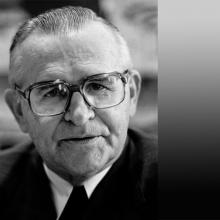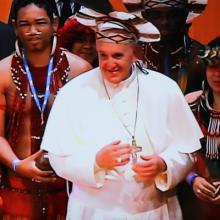rio de janeiro

Image via Shutterstock/Joa Souza
Persecution of these Afro-Brazilian religions, whose adherents are largely poor black Brazilians, has been around since at least the 19th century.
Brazilian Cardinal Paulo Evaristo Arns, one of the most important figures in modern Brazil, died on Dec. 14 in Sao Paulo. He was 95.
Known as Dom Paulo, he was appointed bishop in 1966 and served as archbishop of the Sao Paulo Archdiocese from 1970 to 1998. But he was better known as the “people’s bishop,” and embodied the progressive church movement in South America.
In one of the most inclusive gestures of his visit here, Pope Francis donned a headdress offered to him from an indigenous South American Indian at a ceremony in the city´s grand municipal theater.
The gesture was greeted with shouts of surprise initially. Then the audience of Brazilian politicians and business people erupted into roars of approval and thunderous applause.
It was a compelling moment. Moments earlier, the pope had spoken about the state´s responsibility to respect and encourage “peaceful coexistence between different religions.”
Pope Francis spent Tuesday resting following his arrival here in his first international trip as pope during which his car was mobbed by throngs of well-wishers who excitedly closed in on his convoy and prevented the pontiff from reaching his reception ceremony on time.
His arrival animated tens of thousands of young Catholics cramming the Rio city center, as they waved flags, chanted slogans, and swarmed the four-door Fiat he was riding in.
“It was so amazing when he was selected, we just couldn’t believe it. We cried and hugged one another,” Alicia Velazquez said. “I personally want to see if he’s still the same man as simple and humble whom we all knew. I have faith that he’s remained the same.”
Francis’ driver missed lanes that had been cleared on a boulevard, taking the car down a lane that was not lined with fencing and with no uniformed police in sight to control crowds.
Dozens of Vatican and Brazilian plain-clothes security officials had trouble keeping the crowds back but it did not appear to bother Francis. The bulletproof popemobile was left in Rome.
Francis rolled down his back-seat window, waved to the crowd, and touched those who reached inside. He kissed a baby a woman handed to him.
Six years ago, then-Cardinal Jorge Bergoglio of Buenos Aires attended a gathering of Latin American bishops at the Marian shrine of Aparecida in Rio de Janeiro and called for the Roman Catholic Church to go toward the “outskirts, not only geographically but … existentially.”
Two years after the 2005 papal conclave where Bergoglio was the runner-up to Pope Benedict XVI, the speech helped raise his profile as a man to watch.
Next week, Bergoglio will return to Aparecida and Rio, this time as Pope Francis. Though he won’t visit his native Argentina, the visit will draw attention to Latin America’s first pope and his appeal for a poor church that eschews worldly power.
It's Fat Tuesday. The height of the Mardi Gras celebration. The pinnacle of Carnaval. The time of year when religious and non-religious types alike trek to places like New Orleans and Rio de Janeiro to whoop it up before the season of Lent begins. Granted, most party-goers could likely give a rip about Lent, but to celebrate the storm before the calm is still a tradition many engage in.



